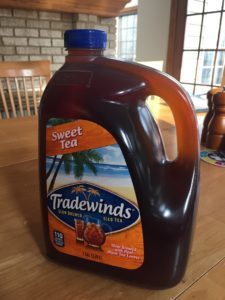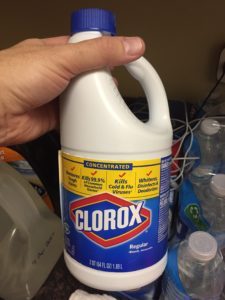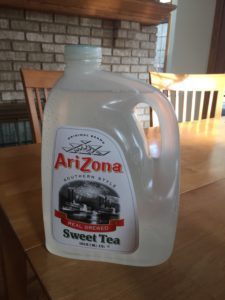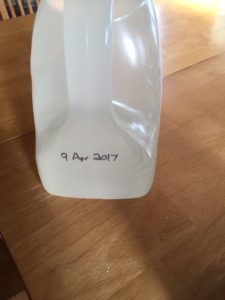Freehold Friday: Practical Prepping and Water Storage!
Howdy Freeholders!
Lots going on today so I’ll just get right to it.
Writing Update
 Solar Storm Episode 3 is officially live right now (go get your copy!) and Episode 4 is now up for preorder! Release date for Episode 4 will be April 28.
Solar Storm Episode 3 is officially live right now (go get your copy!) and Episode 4 is now up for preorder! Release date for Episode 4 will be April 28.
I want to give a big shout out to the ARC Team—you guys are rocking it! So far my favorite catch (by several people) was when one of my characters referred to assessing the situation as “asses”. That one little word changed the whole meaning of that discussion.
On top of all that, the Future History of America Bundle is on sale for $.99 today at Amazon. Normally it’s priced $9.99 so this is the biggest deal yet! This is your chance to get the whole, massive series in one book for less than a buck!
I’m also plugging away at Oathbreaker, Cooper Braaten’s first solo adventure set in the Wildfire Saga. Look for this one in late May or early June–I’ll be able to pinpoint that date next month.
Okay, enough with the updates—on to the blog!
The Blog
Well…that was dramatic.
This week, I thought I’d take a little look at a topic near and dear to preppers everywhere—water storage. Specifically, how someone on a limited budget can quickly amass a significant amount of safe, potable water, and more importantly, store it long term.
So that’s a pretty good segue into the new segment I’ll do from time to time, which I’m calling…
Practical Prepping
Now if you ask “how do I…?” to 10 preppers, you’ll get 10 different answers, and half of them will be about firearms (that’s just how we do things). Well, here’s my answer, and it’s one I’ve been putting into practice for over a year now.
Full Disclaimer: I’m not one of those guys with enough storage space to hold 50 gallon drums of water stacked on top of each other. (Yet) I’m what’s called a practical prepper. See what I did there? I linked back to the segment…the title…nevermind…just keep reading.
To riddle this out, we’ve got to ask several questions up front:
(1) What situation are you preparing for?
(2) What are your water requirements for that situation?
(3) How long do you want to store this water?
(4) What will you put it in (also affects how long you can store)?
(5) How will you make/keep it potable (keep it sanitized and safe to drink)?
So, let’s look at the first question you should ask yourself: What am I preparing for?
The next power outage? A tornado? A hurricane? Maybe a blizzard or ice storm that knocks out power for a week? A chemical spill on the local train tracks? Maybe a terrorist attack or mass shooting event? Or the end of the world and the dreaded zombie apocalypse? Invading whistlepigs from Mars?
Depending on what you’re prepping for, you’ll need to adjust your storage strategy.
For example, if you’re prepping for a tornado, keep in mind they’re relatively short-lived events. They may knock out power to your town for hours or days—sometimes weeks if you’re dealing with an F5 “Finger of God” monster. Hurricanes, however, will likely knock out power and disrupt critical services to your area or state or region for days, weeks, or even months (see Katrina or Andrew or even Sandy).
So how long term are you wanting to store this hypothetical water? The Federal government suggests enough water for each person in your family for 72 hours, as a general “I’m prepared for the average disaster” guideline. But…well, if you’re reading this you’re already someone who doesn’t necessarily believe the government (remember, these are the same people running your local DMV and the IRS) can and will save you in a time a crisis. Pick any disaster where the government had to step in and save lives on a massive scale—it takes them at least three days just to get the requisite paperwork and “official requests” through the proper channels completed before orders go out to get boots on the ground. Remember, in a state-wide emergency (hurricanes, blizzards, etc.) the state governor must ask for help from the Federal government before anything happens. Only when the governors admit they can’t handle the situation on their own (I’m looking at you Louisiana…Katrina was largely blamed on President Bush, but New Orleans’ Mayor Nagin and Governor Blanco waited far too many precious days before they even asked for Federal assistance,) can the Feds take time to issue orders and gather people to ship to the disaster.
So the Federal government in its infinite wisdom suggests 72 hours worth of food and water. Just out of caution, I’d double that at an absolute minimum. My personal goal is a minimum of 1 week, and then take it from there and see how much water I can pack into my basement without Mrs. Richardson noticing.
Okay…so we each need one gallon of water per person per day. A family of four would therefore need 12 gallons (4 people x 1 gallon each per day x 3 days) of water for 72 hours. This stuff will add up quick, folks.
Luckily, I’ve never personally experienced a power outage longer than a day or so (during a hurricane in Florida, and a freak blizzard in Delaware). In a regional grid down event like Hurricane Katrina in New Orleans, the power was out for much longer than 72 hours. Shoot, I’ve seen reports on the Weather Channel when a severe thunderstorm knocked out power to certain towns and regions for days on end. Even squirrels can cause power outages.
As I stated above, a week (minimum) should be your goal. And like a lot of things in the world of prepping, more is better. Water is what’s called mission critical for life—without it, you’re pretty much toast in a few days. Your aim should be to store as much as possible taking into account physical storage limitations.
So our hypothetical family of four would need at 28 gallons of water (4 people x 1 gallon each per day x 7 days) for one week without power. Side note: this all assumes you live in a place where water is pumped to your house either through the municipality pipes where you live, or through a well pump (both of which require electricity to run unless you have a manual well pump or a solar powered pump). If you live out in an EMP hardened log cabin in the woods and use reindeer to turn a capstan to pull water from an alpine lake, just ignore this post and go buy my books.
So…now we’ve answered what, how long, and how much…next we need to ask:
What the hell do we put all this water in, and how to me make it safe?
I won’t get into the science of what containers are safe for water and what aren’t—do a little Googling of your own and you’ll quickly be inundated with arguments and data. A pretty safe rule of thumb is look at what water and drinks are sold in and reuse those containers—with some caveats.
I’ve seen plenty of advice on the internet about reusing milk jugs to store water. This is a bad idea—the thin plastic milk jugs are biodegradable (there’s a lot of those things in landfills after all) and can (some say will) rupture after 6 months or so if stored in a place warmer than a basement. Ever notice how bottled/jugged water has expiration dates? That’s because by the expiration date, the chemicals in the plastic container itself will leach into the water “affecting the taste”. A good rule to remember is if it affects the taste, it can affect your body—skip those containers for storage and drink the water well before the “expiration” date.
Another way to do this is buy a case of water when it’s on sale. Add it to your stockpile and keep track of it. Well before it’s “expiration” drink that water as you normally would (pack it in lunch, take it to the park, feed it to whistelpigs, whatever) and recycle the bottles, then buy another pack. If you do this and your packaged water is “fresh” and up to date, when disaster strikes you’ll have an additional supply of water on hand that’s convenient for travel (if you have to evacuate on short notice, dragging gallons of water jugs around can get…cumbersome). Plus, when you use that water, you’ll have several extra empty containers to catch rainwater or find other sources of fresh drinking water in a disaster. Bonus!
Okay, back on track. When it comes to plastic food containers, remember plastic by its very nature is porous. Ever put cookies in a ziplock bag and seal it really, really, tight…only to come back a few days later and the cookies are getting stale? That’s because air is passing right through the bag at the molecular level. The same thing works for water bottles. How do we get around this obstacle? Use thicker, non-biodegradable plastic.
Okay, so you’ve done some research, skimmed hundreds of articles online, maybe even read some honest-to-God books and you’re ready to start, you just aren’t sure what to do…so you ask me.
Marcus, what the hell do you use?
I use #7 food safe jugs (turn the container over and look for the little recycle triangle symbol on the bottom)
Pic
…they’re thick and won’t biodegrade. I’ve used some for over a year and have no issues with leakage—I’ve read where people have used these things for multiple years without issue, without problems of taste or chemical leakage.
Great, where do you get them? Well, my favorite source is my local grocery store—or even the gas station or Walmart. See, Arizona Ice Tea in the gallon jugs (along with Arnold Palmer Teas and several other brands) use these thick walled, wide-mouth jugs that are just perfect for water storage.

They’re relatively narrow compared to a milk jug and leave a tidier footprint in my opinion. The brands I use the most are Arizona and Tradewinds. Trader Joe’s also uses the same bottle, I think. Look around and you’ll see what I mean. This plastic is thicker and also slightly cloudy—which is good, because the super clear soda bottles that some people use are only good for a few months (less than milk jugs) because they are so porous. Think about it…you put water in a Dr. Pepper bottle and one month later your water tastes like Dr. Pepper. That means the flavor is leaking out of the plastic (you did clean and disinfect it, right??). If the flavor can leak, you need to plan on the chemicals leaking out too.
Okay…I got my jugs but now how do I take the water from my tap and make it safe to drink 6 months or a year from now?
Back to my iced tea jugs. I buy the tea (catch them on sale with they’re 2-for some dollar amount and save money too), then I drink it and wash out the jug with a little soap and water. Once it’s dry, I’ll fill it with clean water from my tap (which is hooked to a deep well that’s filtered, but this would work for city water too). Now you have a neat and tidy gallon of water—congratulations, you can survive for one day.
To purify this water—whether it’s well or city makes no difference—I add Regular Clorox. Remember to skip the fragrance blends—I don’t know how they make bleach smell like a fresh, windswept sunny meadow, but it can’t be natural…you don’t want that dose of chemical sunshine in your drinking water.

A little of this stuff goes a long way, so please be careful, folks. Use some common sense, okay? I’m not going to be responsible for anyone who pours half a bottle of Clorox into their water supplies. We’re not trying to win Darwin Awards here, people.
From Clorox’s own site, it takes:
Don’t have an eyedropper handy to dole out 6 drops (or 8 if you’re using regular bleach)? My method is to use a drinking straw (my little Freeholders are partial to the bendy ones) and poke a tiny hole in the middle with a thumbtack or kitchen knife. Then I put some bleach in it, bend the ends up to trap the bleach in the elbow (where the hole is) and hover it over the jug of water. If you squeeze it just right (practice over the sink first…it only takes a few times to master this, I promise), you can control the flow of drops that dribble out of that little hole. Six drops of concentrated Clorox takes about 5 seconds to apply so don’t skip this step! Nasty stuff can grow in your water if you just fill it and cap it and store it. You put some Clorox in there and nothing will grow because you’re effectively killing everything in the sealed container.
 That’s it! Cap that jug, shake it up a bit to get the bleach all mixed in, label it with the date you filled the container, and store it. Rinse and repeat with each container you have.
That’s it! Cap that jug, shake it up a bit to get the bleach all mixed in, label it with the date you filled the container, and store it. Rinse and repeat with each container you have.
In my case, I buy two at a time, whenever I go to the store or run out of tea…yes, it meant in the beginning I only had a gallon or two of water on hand, but within a few weeks that jumped to about six gallons. After my first month of water storage, I had enough water for my family of 5 to survive that magical federally regulated 72 hour threshold, and I quickly expanded from there. Because…DMV, people. D…M…V.
Okay, so we’ve got the requirements, we’ve got the jugs, we’ve got the water…where do we keep it all?
Remember—plastic is porous, so we don’t want to keep our water anywhere near lots of fumes or chemicals. That means the typical American garage is right out unless you don’t store paint, fertilizer, bug poison, gas, vehicles, or lawnmowers out there (Wow…that makes it seem like every garage is a bomb factory or something). All that nasty stuff puts off trace amounts of chemicals which we’ve already seen can get right into your water supply.
Second, don’t store your plastic water jugs (even if they are the thicker kind) on bare concrete floors (like in the basement for those lucky enough to have one). Concrete these days is made with more than just lime, ash, and water. Over time, trace chemicals can leach up into your containers if they’re just sitting there on the concrete day in and day out for months (or years) at a time. So keep your water jugs away from plastics too—basically anything manmade will contain chemicals that can leach through plastics of all kind given enough time.
The solution? Put wood on the floor, then put your water on that. I’ve seen people use tubafores (2x4s, or Texas toothpicks for those who aren’t woodworkers) spaced out enough to support their water containers and plywood sheets, as well as just about any other type of wood you can think of.
Except one: treated wood. Stay away from treated wood at all costs—sitting the water on the concrete is much better than using treated wood because those things are just saturated with arsenic and all kinds of nasty stuff that will quickly get into your water and contaminate it.
Other than those simple guidelines, you can pretty much be as creative (or not) in your water storage. Do a Google search on water storage and you’ll see what I mean. I’ve seen plywood and tubafore racks, I’ve seen tubafores just laying on the ground, I’ve seen hanging systems, underground cisterns Maud’Dib would be proud of, supplies hidden in coat closets, under furniture…you name it. Water is heavy (8 pounds per gallon) so keep that in mind when designing your storage. You don’t want something collapsing in the middle of the night and wake up to a flooded basement.
One last thing I want to touch on—rotation. Like all our preps (especially food and water) I recommend getting in the habit of rotating your stock. Keep a list or spreadsheet of what you’ve got and where it’s at (you do have an emergency binder for your non-prepping family members to follow should you be away from home when disaster strikes, right? No? Well, fear not, Freeholder, we’ll touch on this in another post).
When the expiration date on an item is approaching (like a month or two away depending on what it is), use that item in your everyday cooking or whatever. Then the next time you’re at the store or preparing preps, replace it and add one more item to the stockpile. That way your supply never goes bad and you also add a little bit each time you remove something.
Your water is no different. It will never expire per se, but some people don’t like the flat taste of water that’s been stored for months or years. To solve this, you could shake up the container and oxygenate it. Or, if there is no crisis and you want to maintain “fresh” water on hand at all times, why not just use what you’ve got by pouring it on the garden, or giving it to your pets, spraying whistlepigs with a Super Soaker, or using it for household cleaning…the possibilities are endless—we use a lot of water each day.
Just remember, replace what you use—immediately.
Then, the next time the power goes out, for any reason, you won’t have to worry about water…at least not right away. You did save enough for more than 72 hours…right? Because those folks at FEMA say 72 is what you need. And if it’s good enough for the government, a kindergartner can find a way to make it better.
Until next time, y’all: keep your heads down and your powder dry, my friends. Now go store some water!





